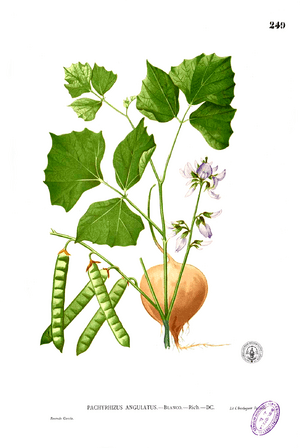Pachyrhizus facts for kids
Quick facts for kids Pachyrhizus |
|
|---|---|
 |
|
| Scientific classification |
|
| Kingdom: | Plantae |
| Clade: | Tracheophytes |
| Clade: | Angiosperms |
| Clade: | Eudicots |
| Clade: | Rosids |
| Order: | Fabales |
| Family: | Fabaceae |
| Subfamily: | Faboideae |
| Tribe: | Phaseoleae |
| Subtribe: | Glycininae |
| Genus: | Pachyrhizus Rich. ex DC. |
| Species | |
|
|
| Synonyms | |
|
|
Pachyrhizus is a small group of five or six types of tropical and subtropical plants. These plants grow from large roots that are often good to eat.
Contents
What is Jícama?
The jícama (Pachyrhizus erosus) is also known as the yam bean. It is a climbing plant grown for its big, round or long root. This root can be 10–15 centimeters (about 4-6 inches) wide and weigh up to 20 kilograms (about 44 pounds)!
When you peel off its thick, brown skin, you find white flesh inside. You can eat this part cooked or raw. It is crunchy, moist, and a little sweet. Many people say it tastes a bit like an apple.
Parts of the Jícama Plant
The jícama plant also makes seeds that look like lima beans. Sometimes, people eat these seeds when they are young. However, the mature seeds have a lot of a chemical called rotenone. This chemical is used to kill insects and pests. It is important to know that most of the jícama plant, except for the root, is very poisonous. So, only eat the root!
Where Jícama Comes From
Jícama first grew in the New World, which includes Central and South America. The name "jícama" comes from these regions. Today, Pachyrhizus erosus is grown all over Asia. In China, it is called "cold potato." In Malaysia, it is "sengkuang," and in Indonesia, "bengkoang." In the Philippines, it is "singkamas," and in Thailand, "mankew." People enjoy eating it raw or in stir-fried dishes.
The Amazonian Yam Bean
Goiteño, nupe, jacatupe, or the Amazonian yam bean (Pachyrhizus tuberosus) is a plant that grows every year. It has a stem that wraps around things and a woody base. This plant has white and purple flowers. Its pods are 10 to 20 centimeters (about 4-8 inches) long. The beans inside these pods have a lot of protein, about 32%.
Each plant grows two or more roots, called tubercles. These roots are 15 to 25 centimeters (about 6-10 inches) long. They are juicy, sweet, and full of starch and protein (about 9%). You can eat them raw or cooked. The leaves, which have 20 to 24% protein, and the pods are also safe to eat. This plant grows well in acidic soils in the tropical rainforests of South America. Native people in the Amazon rainforest have grown it for a long time.
Ahipa: The Andean Yam Bean
The ahipa, ajipa, or Andean yam bean (Pachyrhizus ahipa) is very similar to jícama and goiteño. It has similar features and uses. But unlike jícama, ahipa does not grow as a climbing vine. It can grow up to 2,000 meters (about 6,500 feet) above sea level in the high mountains of Bolivia.
The root of the ahipa plant is smaller and longer than jícama. Not many people outside the Andes mountains know about it. Most of the time, people grow it for themselves or for local use. In the 1800s, scientists from Britain brought ahipa to the West Indies. People living on those islands enjoy eating it too.
Jícama (P. erosus) is the most popular type of Pachyrhizus grown and eaten, especially in the US. Another type, P. palmatilobus, does not taste as good.
See also
 In Spanish: Jicama para niños
In Spanish: Jicama para niños

